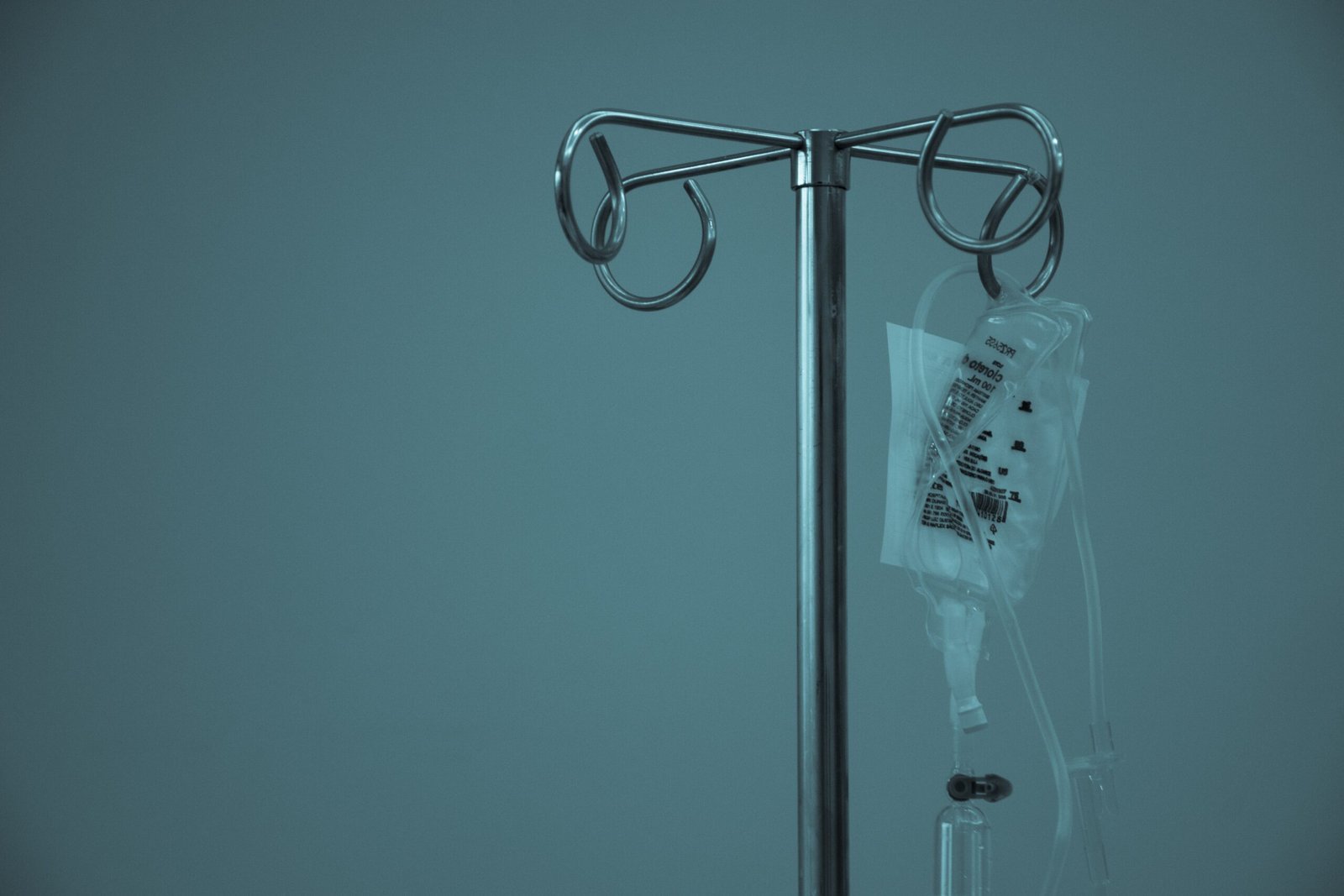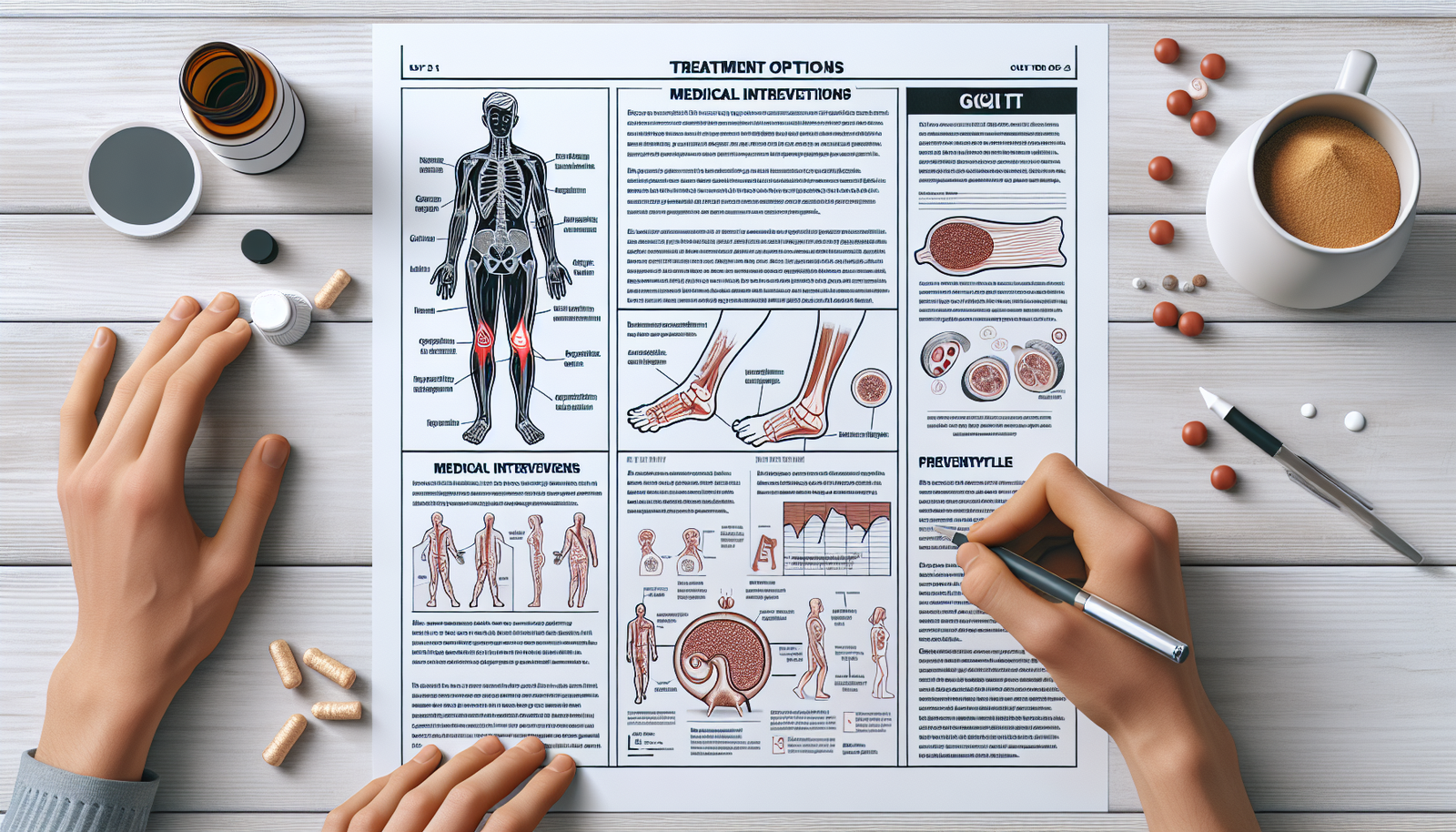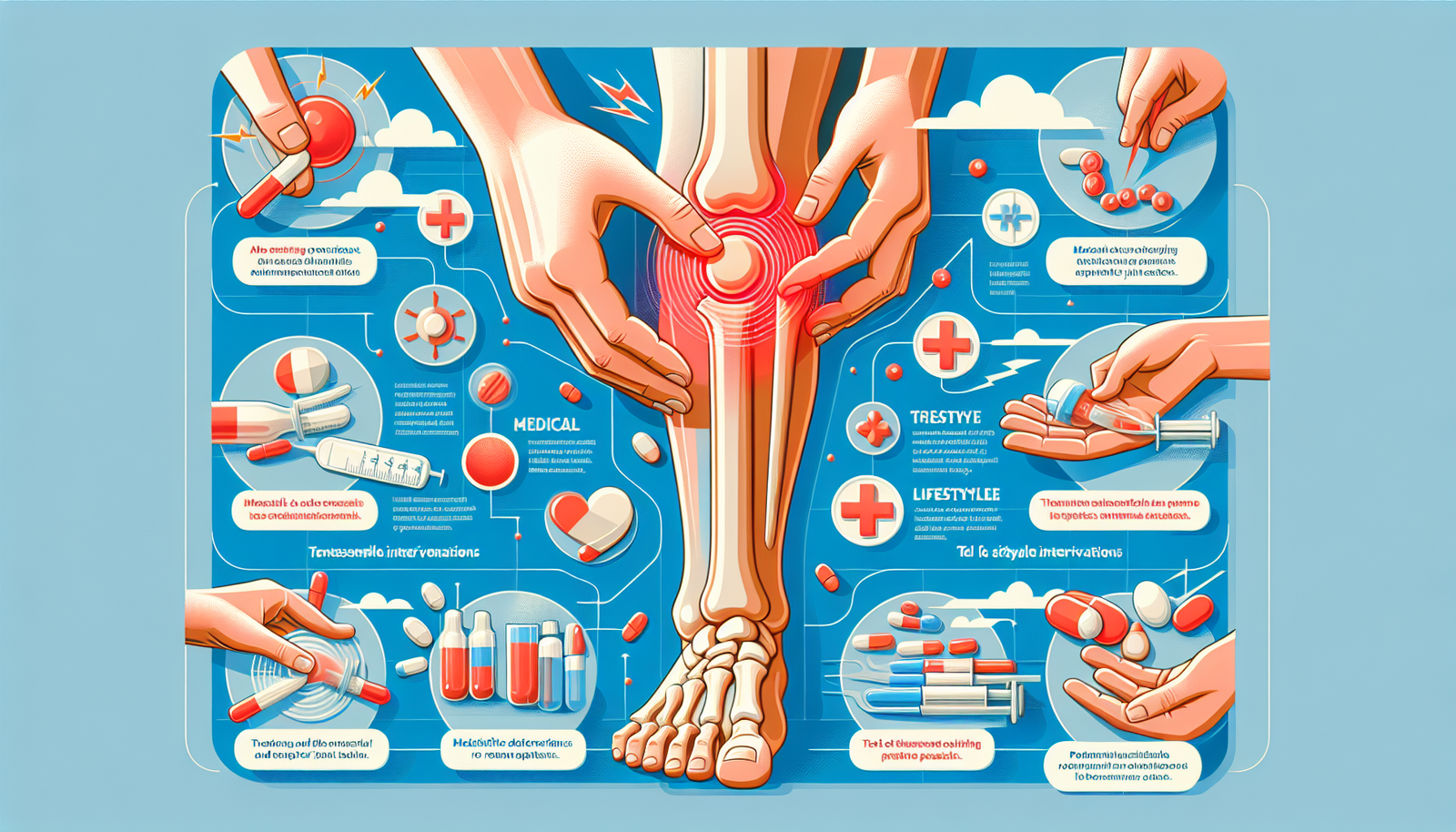Sure thing! So you're probably wondering if gout, that pesky condition known for its excruciating joint pain, can actually be treated, right? Well, the good news is that there are indeed treatment options available for this condition. From lifestyle changes to medication, there are several approaches that can help manage gout and keep those painful flare-ups at bay. In this article, we'll explore some of these treatment methods and how they can make a difference in your life. So, let's get started and find out how to effectively tackle gout!

Explanation of Gout
Gout is a type of arthritis that is characterized by sudden and severe attacks of pain, swelling, redness, and tenderness in the joints. It most commonly affects the joint at the base of the big toe, but can also occur in other joints such as the ankles, knees, wrists, and elbows. Gout occurs when there is a buildup of uric acid in the body, which leads to the formation of sharp urate crystals in the joints. These crystals cause inflammation and intense pain. Gout is a chronic condition, but with proper treatment and management, the frequency and severity of gout attacks can be reduced.
Definition and Symptoms of Gout
Gout is a form of arthritis caused by the accumulation of urate crystals in the joints. Urate crystals are formed when there is an excess amount of uric acid in the blood. The symptoms of gout typically develop rapidly and often occur at night. They can include:
- Intense joint pain: The affected joint is usually red, swollen, hot, and extremely tender to the touch.
- Limited range of motion: Movement in the affected joint may be restricted due to swelling and pain.
- Inflammation and redness: The skin around the affected joint may become inflamed and appear red.
- Tophi: In some cases, small, chalky deposits called tophi may develop under the skin around the joints, especially in advanced stages of gout.
If you experience these symptoms, it is important to seek medical attention for an accurate diagnosis.
Causes of Gout
Gout is primarily caused by the overproduction or underexcretion of uric acid. Uric acid is a waste product that is produced when the body breaks down purines, which are naturally occurring substances found in certain foods and in the body's cells. When there is an excessive amount of uric acid in the blood, it can form urate crystals in the joints, leading to gout.
Certain factors can contribute to the development of gout, including:
- Diet: Consuming a diet high in purine-rich foods, such as red meat, seafood, and alcohol, can increase the levels of uric acid in the body.
- Obesity: Being overweight or obese increases the risk of developing gout, as it is associated with higher levels of uric acid.
- Genetics: Gout can run in families, indicating a genetic predisposition to the condition.
- Medical conditions: Certain medical conditions, such as high blood pressure, kidney disease, and diabetes, can increase the likelihood of developing gout.
Risk Factors for Gout
There are several risk factors that can increase your chances of developing gout. These include:
- Gender: Men are more prone to developing gout than women, typically starting in their 40s or 50s. However, women have an increased risk after menopause.
- Family history: If you have a family history of gout, you are at a higher risk of developing the condition.
- Age: Gout becomes more common with age, as the body's ability to process uric acid decreases.
- Certain medications: Certain medications, such as diuretics used to treat high blood pressure, can increase the risk of gout by raising uric acid levels.
- Excessive alcohol consumption: Regular and excessive alcohol consumption, particularly beer, can increase the likelihood of developing gout.
It is important to be aware of these risk factors and take steps to manage and reduce your risk of developing gout.
Diagnosing Gout
If you are experiencing symptoms consistent with gout, your healthcare provider will conduct a thorough examination and may order various tests to confirm the diagnosis. The diagnosis of gout typically involves the following:
Physical Examination
During a physical examination, your healthcare provider will assess the affected joint and look for signs of inflammation, such as redness, swelling, and tenderness. They will also inquire about your medical history and any previous gout attacks.
Joint Aspiration
Joint aspiration, also known as joint fluid analysis, involves the removal of fluid from the affected joint using a needle. This procedure allows for the examination of the joint fluid under a microscope to identify the presence of urate crystals. The presence of these crystals is a key indicator of gout.
Blood Tests
Blood tests can help measure the levels of uric acid in your blood. However, it is important to note that a high uric acid level does not necessarily confirm a diagnosis of gout, as some individuals with high levels may never experience gout symptoms. Blood tests may also be used to rule out other conditions with similar symptoms, such as infection or rheumatoid arthritis.
Imaging Tests
In some cases, imaging tests such as X-rays, ultrasound, or computed tomography (CT) scans may be performed to assess the affected joint and surrounding tissues. These tests can help identify signs of joint damage or other conditions that may be causing the symptoms.
It is important to undergo a thorough diagnostic evaluation to ensure an accurate diagnosis and develop an appropriate treatment plan.
Treating Acute Gout Attacks
When it comes to managing gout, the primary goal during an acute gout attack is to relieve pain and reduce inflammation. The following treatment options are commonly used for acute gout attacks:
Pain Relief Medications
Over-the-counter nonsteroidal anti-inflammatory drugs (NSAIDs) such as ibuprofen or naproxen can help alleviate pain and reduce inflammation during a gout attack. These medications work by reducing the production of certain chemicals in the body that cause pain and inflammation. It is important to follow the recommended dosage and speak with your healthcare provider if you have any pre-existing conditions or take other medications.
Nonsteroidal Anti-Inflammatory Drugs (NSAIDs)
In some cases, your healthcare provider may prescribe stronger NSAIDs or corticosteroids to help relieve pain and reduce inflammation during a gout attack. These medications can provide more effective and targeted relief, but they may also have potential side effects. It is important to follow your healthcare provider's instructions and report any adverse effects.
Colchicine
Colchicine is a medication that can be used to relieve pain and reduce inflammation during acute gout attacks. It works by inhibiting certain inflammatory processes in the body. Colchicine is typically taken in tablet form and should be taken at the first sign of a gout attack for maximum effectiveness. It is important to note that colchicine can have side effects, such as gastrointestinal symptoms, and may interact with other medications.
Corticosteroids
Corticosteroids, such as prednisone, can be prescribed to help reduce pain and inflammation in severe cases of gout. These medications are typically administered orally or by injection. Corticosteroids can provide rapid relief, but they may also have potential side effects, especially with long-term use. Your healthcare provider will determine the most appropriate corticosteroid dosage and duration based on your individual needs.
Long-Term Management and Prevention of Gout
In addition to managing acute gout attacks, long-term management and prevention of gout are crucial to reduce the frequency and severity of future attacks. The following strategies can help manage and prevent gout:
Lifestyle Changes
Making certain lifestyle changes can have a positive impact on gout management. It is important to maintain a healthy weight, as obesity is a risk factor for gout. Regular physical activity and exercise can help manage weight and improve overall joint health. Avoiding excessive alcohol consumption, particularly beer, can also help reduce the risk of gout.
Dietary Modifications
Adopting a gout-friendly diet can help lower uric acid levels and prevent gout attacks. This includes reducing the intake of purine-rich foods, such as organ meats, shellfish, and red meat. Instead, focus on consuming low-purine foods like vegetables, whole grains, low-fat dairy products, and plant-based proteins. It is also important to stay hydrated and limit sugary beverages, as adequate fluid intake helps the body flush out uric acid.
Weight Management
Maintaining a healthy weight is crucial in managing gout, as obesity is associated with higher uric acid levels. Losing weight gradually and adopting strategies for long-term weight management can help reduce the frequency and severity of gout attacks. It is advisable to consult a healthcare professional or registered dietitian for personalized advice and support.
Fluid Intake
Drinking an adequate amount of fluids, especially water, can help dilute uric acid and promote its excretion through the kidneys. Aim to consume at least eight glasses of water per day and increase fluid intake during exercise or in hot weather. However, it is important to consult your healthcare provider if you have any underlying medical conditions that may require fluid restriction.
Medication to Lower Uric Acid Levels
If you experience frequent gout attacks or have elevated uric acid levels, your healthcare provider may prescribe medication to lower uric acid levels. These medications, such as allopurinol or febuxostat, work by reducing the production or increasing the excretion of uric acid. It is important to take these medications as prescribed and undergo regular monitoring to ensure their effectiveness and safety.

Alternative Treatments for Gout
While there is limited scientific evidence supporting the effectiveness of alternative treatments for gout, some individuals report finding relief with the following approaches:
Cherry Juice
Cherry juice, particularly tart cherry juice, has been suggested to help reduce gout attacks. Cherries contain compounds that may have anti-inflammatory properties and help lower uric acid levels. However, more research is needed to determine the optimal dosage and efficacy of cherry juice as a complementary treatment for gout.
Apple Cider Vinegar
Some individuals claim that consuming apple cider vinegar can help alleviate gout symptoms. However, there is limited scientific evidence to support this claim. It is important to discuss the use of apple cider vinegar or any other alternative treatments with your healthcare provider before incorporating them into your gout management plan.
Herbal Remedies
Certain herbs, such as devil's claw, turmeric, and ginger, have traditionally been used to relieve inflammatory conditions. However, it is important to note that these herbal remedies may interact with medications or have potential side effects. Consult with a healthcare professional or qualified herbalist before using herbal remedies for gout.
Acupuncture
Acupuncture involves the insertion of thin needles into specific points on the body to promote balance and alleviate pain. Some individuals report finding relief from gout symptoms through acupuncture sessions. While the evidence supporting acupuncture for gout is limited, it may be worth exploring as a complementary treatment option. It is crucial to seek acupuncture from a qualified and licensed provider.
Managing Coexisting Health Conditions
If you have coexisting health conditions such as hypertension, diabetes, or obesity, managing these conditions is crucial in effectively managing gout. Proper control of hypertension and diabetes can help reduce the risk of gout attacks and minimize complications. Adopting a healthy lifestyle, including regular exercise and a balanced diet, can also support weight management and reduce the impact of obesity on gout.
Potential Complications of Untreated Gout
If left untreated or poorly managed, gout can lead to various complications, including:
Chronic Gout
Chronic gout occurs when gout attacks become more frequent and the formation of urate crystals in the joints becomes persistent. This can lead to ongoing inflammation and joint damage, causing chronic pain and loss of joint function.
Tophi
Tophi are chalky deposits that form under the skin around joints affected by gout. These deposits can cause further inflammation and joint damage if left untreated. Tophi can break through the skin, leading to open sores and ulcers.
Kidney Stones
High levels of uric acid in the blood can lead to the formation of uric acid kidney stones. These stones can cause severe pain and may require medical intervention to remove or break them apart.
It is essential to seek proper treatment and management for gout to prevent these complications and maintain optimal joint health.
Surgery for Gout
In some cases, surgery may be necessary to manage advanced stages of gout or when conservative treatments have not provided adequate relief. The following surgical options are available for gout:
Joint Repair
In cases where gout has caused significant joint damage, joint repair surgery may be recommended. This procedure aims to reconstruct or repair damaged joint structures, such as tendons or ligaments, to improve joint function and reduce pain.
Joint Fusion
Joint fusion surgery, also known as arthrodesis, involves fusing the affected joint bones together. This procedure eliminates movement in the joint, reducing pain and stabilizing the joint. Joint fusion is typically recommended for joints that are severely damaged and not amenable to other treatment options.
Joint Replacement
In extreme cases of joint damage, joint replacement surgery may be necessary. This involves removing the damaged joint and replacing it with an artificial joint. Joint replacement surgery can significantly improve joint function, reduce pain, and restore mobility.
Surgical interventions for gout should be considered on an individual basis, in consultation with a healthcare provider.

Tips for Living with Gout
Living with gout requires a proactive approach to reduce the frequency and severity of gout attacks. The following tips can help you effectively manage gout and improve your quality of life:
Educating Yourself about Gout
Understanding the causes, symptoms, and triggers of gout can empower you to make informed decisions about lifestyle modifications and treatment choices. Stay updated with reliable sources of information and seek guidance from healthcare professionals or support groups.
Managing Pain and Inflammation
During acute gout attacks, it is important to prioritize pain management and reduce inflammation. Follow your healthcare provider's recommendations for medication use and explore alternative therapies, such as applying cold or warm compresses, to help alleviate pain and discomfort.
Supportive Footwear
Proper footwear can play a significant role in gout management. Opt for shoes that provide ample support, cushioning, and a comfortable fit to minimize joint stress and reduce the risk of gout attacks. Consult with a podiatrist or footwear specialist for guidance on selecting appropriate shoes.
Exercise and Physical Therapy
Engaging in regular low-impact exercises, such as swimming, cycling, or gentle walking, can help maintain joint function, strengthen muscles, and manage weight. Additionally, working with a physical therapist can provide targeted exercises and techniques to improve joint mobility and reduce the risk of gout attacks.
Conclusion
Gout is a chronic condition characterized by acute attacks of joint pain, swelling, and inflammation. It is primarily caused by the buildup of uric acid in the joints, leading to the formation of sharp urate crystals. Proper diagnosis, treatment, and lifestyle modifications are essential in managing gout effectively and reducing the frequency of gout attacks. By adopting healthy habits, making dietary changes, and following your healthcare provider's recommendations, you can minimize the impact of gout on your daily life and maintain optimal joint health. Remember to seek proper medical advice and support to develop a personalized management plan for your specific needs.


